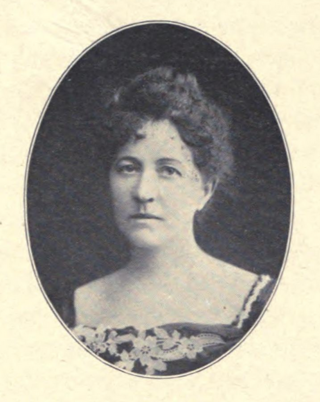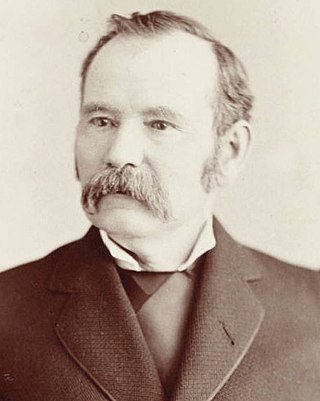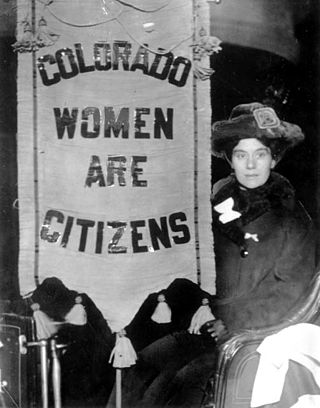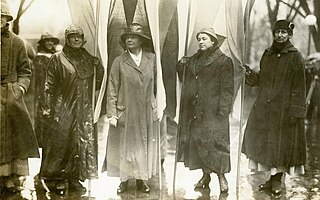
John Long Routt was an American politician of the Republican Party. Born in Eddyville, Kentucky, he served as the first and seventh governor of Colorado from 1876 to 1879 and 1891 to 1893. He also served as mayor of Denver, Colorado from 1883 to 1885. He died in Denver, Colorado.
Margaret W. Campbell was an American women's suffrage advocate.
This timeline highlights milestones in women's suffrage in the United States, particularly the right of women to vote in elections at federal and state levels.

Ellis Meredith (1865–1955) was an American suffragist, journalist, and novelist, known as the Susan B. Anthony of Colorado.

Women's suffrage was established in the United States on a full or partial basis by various towns, counties, states and territories during the latter decades of the 19th century and early part of the 20th century. As women received the right to vote in some places, they began running for public office and gaining positions as school board members, county clerks, state legislators, judges, and, in the case of Jeannette Rankin, as a member of Congress.

Eliza Pickrell Routt (1839–1907) was a pioneer in womens' suffrage and the original first lady of the state of Colorado.

The 1876 Colorado gubernatorial election took place on October 3, 1876, to elect the 1st Governor of Colorado after the state was admitted to the union on August 1, 1876. Republican John Long Routt, last governor of the Colorado Territory, was elected in a close race against Democratic nominee Bela M. Hughes.

Women's suffrage in Ohio was an ongoing fight with some small victories along the way. Women's rights issues in Ohio were put into the public eye in the early 1850s. Women inspired by the Declaration of Rights and Sentiments at the 1848 Seneca Falls Convention created newspapers and then set up their own conventions, including the 1850 Ohio Women's Rights Convention which was the first women's right's convention outside of New York and the first that was planned and run solely by women. These early efforts towards women's suffrage affected people in other states and helped energize the women's suffrage movement in Ohio. Women's rights groups formed throughout the state, with the Ohio Women's Rights Association (OWRA) founded in 1853. Other local women's suffrage groups are formed in the late 1860s. In 1894, women won the right to vote in school board elections in Ohio. The National American Woman Suffrage Association (NAWSA) was headquartered for a time in Warren, Ohio. Two efforts to vote on a constitutional amendment, one in 1912 and the other 1914 were unsuccessful, but drew national attention to women's suffrage. In 1916, women in East Cleveland gained the right to vote in municipal elections. A year later, women in Lakewood, Ohio and Columbus were given the right to vote in municipal elections. Also in 1917, the Reynolds Bill, which would allow women to vote in the next presidential election was passed, and then quickly repealed by a voter referendum sponsored by special-interest groups. On June 16, 1919, Ohio became the fifth state to ratify the Nineteenth Amendment.

This is a timeline of women's suffrage in Ohio. Women's suffrage activism in Ohio began in earnest around the 1850s, when several women's rights conventions took place around the state. The Ohio Women's Convention was very influential on the topic of women's suffrage, and the second Ohio Women's Convention in Akron, Ohio, featured Sojourner Truth and her famous speech, Ain't I a Woman? Women worked to create organizations and groups to influence politicians on women's suffrage. Several state constitutional amendments for women's suffrage did not pass. However, women in Ohio did get the right to vote in school board elections and in some municipalities before Ohio became the fifth state to ratify the Nineteenth Amendment.

Women's suffrage in Nevada began in the late 1860s. Lecturer and suffragist, Laura de Force Gordon, started giving women's suffrage speeches in the state starting in 1867. In 1869, Assemblyman Curtis J. Hillyer introduced a women's suffrage resolution in the Nevada Legislature. He also spoke out on women's rights. Hillyer's resolution passed, but like all proposed amendments to the state constitution, must pass one more time and then go out to a voter referendum. In 1870, Nevada held its first women's suffrage convention in Battle Mountain Station. In the late 1880s, women gained the right to run for school offices and the next year several women are elected to office. A few suffrage associations were formed in the mid 1890s, with a state group operating a few women's suffrage conventions. However, after 1899, most suffrage work slowed down or stopped altogether. In 1911, the Nevada Equal Franchise Society (NEFS) was formed. Attorney Felice Cohn wrote a women's suffrage resolution that was accepted and passed the Nevada Legislature. The resolution passed again in 1913 and will go out to the voters on November 3, 1914. Suffragists in the state organized heavily for the 1914 vote. Anne Henrietta Martin brought in suffragists and trade unionists from other states to help campaign. Martin and Mabel Vernon traveled around the state in a rented Ford Model T, covering thousands of miles. Suffragists in Nevada visited mining towns and even went down into mines to talk to voters. On November 3, the voters of Nevada voted overwhelmingly for women's suffrage. Even though Nevada women won the vote, they did not stop campaigning for women's suffrage. Nevada suffragists aided other states' campaigns and worked towards securing a federal suffrage amendment. On February 7, 1920, Nevada became the 28th state to ratify the Nineteenth Amendment.

This is a timeline of women's suffrage in Nevada. In 1869, Curtis J. Hillyer introduced a women's suffrage resolution in the Nevada Legislature which passed, though it would wait for another legislative session to approve a second time. The first women's suffrage convention took place in 1870 in Battle Mountain Station. Several women's suffrage resolutions are voted on, or approved, but none complete the criteria to become amendments to the Constitution of Nevada. In the 1880s, women gain the right to run for school offices and several women run and win. Some Nevada women's suffrage groups work throughout the 1890s and hold more conventions. However, most suffrage work slows down or stops around 1899. The Nevada Equal Franchise Society (NEFS) was created in 1911. That same year, Attorney Felice Cohn writes a women's suffrage resolution that is accepted and passed by the Nevada Legislature. Anne Henrietta Martin becomes president of NEFS in 1912. The next year, Cohn's resolution passes a second time and will go out as a voter referendum the next year. On November 3, 1914 Nevada voters approve women's suffrage. Women in Nevada continue to be involved in suffrage campaigning. On February 7, 1920 Nevada ratifies the Nineteenth Amendment.

While women's suffrage in Maine had an early start, dating back to the 1850s, it was a long, slow road to equal suffrage. Early suffragists brought speakers Susan B. Anthony and Lucy Stone to the state in the mid-1850s. Ann F. Jarvis Greely and other women in Ellsworth, Maine, created a women's rights lecture series in 1857. The first women's suffrage petition to the Maine Legislature was also sent that year. Working-class women began marching for women's suffrage in the 1860s. The Snow sisters created the first Maine women's suffrage organization, the Equal Rights Association of Rockland, in 1868. In the 1870s, a state suffrage organization, the Maine Women's Suffrage Association (MWSA), was formed. Many petitions for women's suffrage were sent to the state legislature. MWSA and the Woman's Christian Temperance Union (WCTU) of Maine worked closely together on suffrage issues. By the late 1880s the state legislature was considering several women's suffrage bills. While women's suffrage did not pass, during the 1890s many women's rights laws were secured. During the 1900s, suffragists in Maine continued to campaign and lecture on women's suffrage. Several suffrage organizations including a Maine chapter of the College Equal Suffrage League and the Men's Equal Rights League were formed in the 1910s. Florence Brooks Whitehouse started the Maine chapter of the National Woman's Party (NWP) in 1915. Suffragists and other clubwomen worked together on a large campaign for a 1917 voter referendum on women's suffrage. Despite the efforts of women around the state, women's suffrage failed. Going into the next few years, a women's suffrage referendum on voting in presidential elections was placed on the September 13, 1920 ballot. But before that vote, Maine ratified the Nineteenth Amendment on November 5, 1920. It was the nineteenth state to ratify. A few weeks after ratification, MWSA dissolved and formed the League of Women Voters (LWV) of Maine. White women first voted in Maine on September 13, 1920. Native Americans in Maine had to wait longer to vote. In 1924, they became citizens of the United States. However, Maine would not allow individuals living on Indian reservations to vote. It was not until the passage of a 1954 equal rights referendum that Native Americans gained the right to vote in Maine. In 1955 Lucy Nicolar Poolaw (Penobscot) was the first Native American living on a reservation in Maine to cast a vote.

This is a timeline of women's suffrage in Wisconsin. Women's suffrage efforts began before the Civil War. The first Wisconsin state constitutional convention in 1846 discussed both women's suffrage and African-American suffrage. In the end, a more conservative constitution was adopted by Wisconsin. In the 1850s, a German language women's rights newspaper was founded in Milwaukee and many suffragists spoke throughout the state. The first state suffrage convention was held in Janesville in 1867. The 1870s, several women's suffrage groups were founded in the state. In 1884, a women's suffrage bill, allowing women to vote for school-related issues is passed. In 1886, voters approve the school-related suffrage bill in a referendum. The first year women vote, 1887, there are challenges to the law that go on until Wisconsin women are allowed to vote again for school issues in 1902 using separate ballots. In the 1900s, women's suffrage conventions continue to take place throughout the state. Women collect petitions and continue to lobby the state legislature. In 1911 Wisconsin legislature passes a bill for women's suffrage that will go out to the voters in 1912. On November 4, 1912 voters disapprove of women's suffrage. Women's suffrage efforts continue, including sponsoring a suffrage school and with the inclusion of a National Woman's Party (NWP) chapter formed in 1915. When the Nineteenth Amendment goes out to the states, Wisconsin ratifies on June 10 and turns in the ratification paperwork first, on June 13, 1919.

Women's suffrage in Colorado had an early victory, being the second state to grant women's suffrage and the first to do so through a voter referendum in 1893. Even while Colorado was a territory, lawmakers and other leaders tried to include women's suffrage in laws and later in the state constitution. The constitution did give women the right to vote in school board elections. The first voter referendum campaign was held in 1877. The Woman Suffrage Association of Colorado worked to encourage people to vote yes. Nationally-known suffragists, such as Susan B. Anthony and Lucy Stone spoke alongside Colorado's own Alida Avery around the state. Despite the efforts to influence voters, the referendum failed. Suffragists continued to grow support for women's right to vote. They exercised their right to vote in school board elections and ran for office. In 1893, another campaign for women's suffrage took place. Both Black and white suffragists worked to influence voters, gave speeches, and turned out on election day in a last-minute push. The effort was successful and women earned equal suffrage. In 1894, Colorado again made history by electing three women to the Colorado house of representatives. After gaining the right to vote, Colorado women continued to fight for suffrage in other states. Some women became members of the Congressional Union (CU) and pushed for a federal suffrage amendment. Colorado women also used their right to vote to pass reforms in the state and to support women candidates.

This is a timeline of women's suffrage in Colorado. Women's suffrage efforts started in the late 1860s. During the state constitutional convention for Colorado, women received a small win when they were granted the right to vote in school board elections. In 1877, the first women's suffrage referendum was defeated. In 1893, another referendum was successful. After winning the right to vote, Colorado women continued to fight for a federal women's suffrage amendment. While most women were able to vote, it wasn't until 1970 that Native Americans living on reservations were enfranchised.

Women's suffrage in North Dakota began when North Dakota was still part of the Dakota Territory. During this time activists worked for women's suffrage, and in 1879, women gained the right to vote at school meetings. This was formalized in 1883 when the legislature passed a law where women would use separate ballots for their votes on school-related issues. When North Dakota was writing its state constitution, efforts were made to include equal suffrage for women, but women were only able to retain their right to vote for school issues. An abortive effort to provide equal suffrage happened in 1893, when the state legislature passed equal suffrage for women. However, the bill was "lost," never signed and eventually expunged from the record. Suffragists continued to hold conventions, raise awareness, and form organizations. The arrival of Sylvia Pankhurst in February 1912 stimulated the creation of more groups, including the statewide Votes for Women League. In 1914, there was a voter referendum on women's suffrage, but it did not pass. In 1917, limited suffrage bills for municipal and presidential suffrage were signed into law. On December 1, 1919, North Dakota became the twentieth state to ratify the Nineteenth Amendment.

This is a timeline of women's suffrage in North Dakota. Women's suffrage in North Dakota began while it was still part of the Dakota Territory. In 1879, women in the territory gained the right to vote in school meetings. Later, this was more formalized in 1883, providing women separate ballots for school issues. After North Dakota was a state, suffragists continued to work for full suffrage. A referendum on equal suffrage took place in 1914, but failed. In 1917, women gained the right to vote in municipal and presidential elections. On December 1, 1919, North Dakota became the 20th state to ratify the Nineteenth Amendment.

This is a timeline of women's suffrage in South Dakota. The early history of women's suffrage in the state is shared with North Dakota. When South Dakota became a state, it held a voter referendum in 1890 on an equal suffrage amendment. This effort failed, but suffragists continued to organize and lobby the legislature to pass voter referendums. None passed until 1918. South Dakota ratified the Nineteenth Amendment on December 4, 1919.

Minnie Reynolds Scalabrino was an American journalist, women's rights activist, and organizer, founding the Denver Women's Press Club and Denver Woman's Club. She advocated for equal rights, women's suffrage and temperance, something that she was devoted to for more than 30 years. She was instrumental in the passage of laws that gave women the right to vote at the state level, and then in 1920 for women throughout the United States.


















